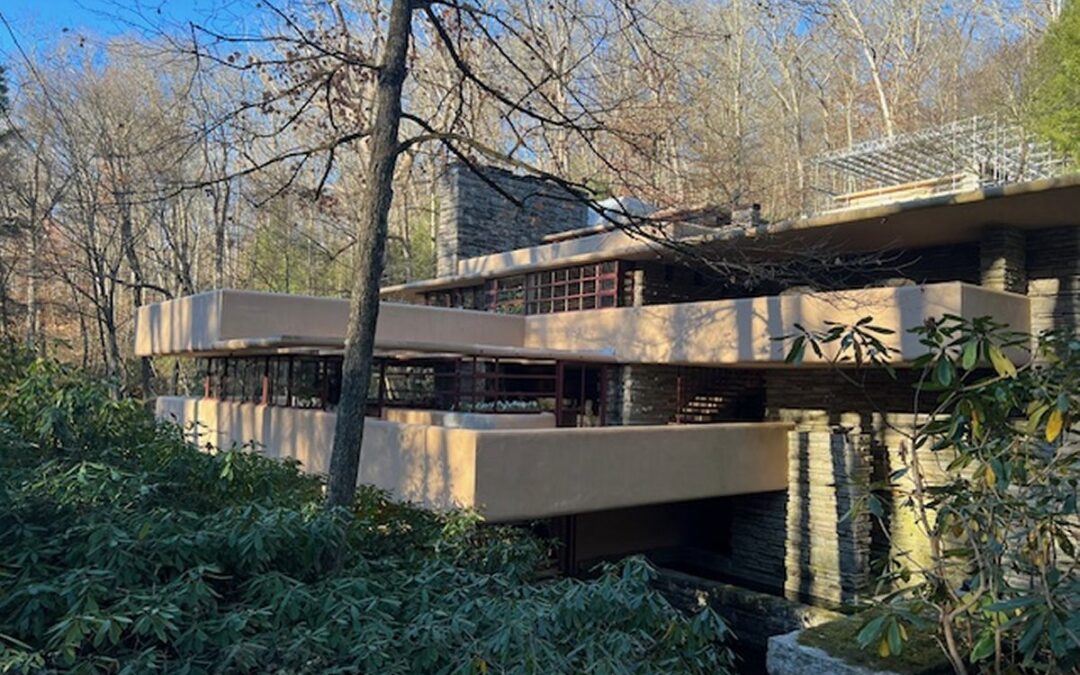Few residential buildings have had more impact on the modern office than Frank Lloyd Wright’s Fallingwater. It was built in the late 1930s in Western Pennsylvania. As a college architecture student in Pennsylvania, Wright’s presence was still unescapable half a century later. Still, I had never seen it in person until yesterday.
Fallingwater is a snapshot of design and space utilization from almost a hundred years ago that is frozen in time. The decor is probably closer to the 1950s, but that’s the last time anyone may have redecorated before it was donated to a non-profit as a historic place.
There’s a certain irony to the house today. Many of the principles from this house led to the rise and ultimate fall of the modern office during the pandemic. And if this was on AirBnB, it would probably be the ultimate remote work location. To say Fallingwater is in the middle of nowhere still gives you some context of where it is. The middle of nowhere is probably easier to get to. It was designed as a second home for a family in the Pittsburgh area. Just getting there from the Pittsburgh area in 2024 is a challenge. You go up one mountain and down the next and repeat several times. I can’t imagine what the drive was like in 1935.
What We Learned
Fallingwater had a significant influence on the design principles that later evolved into mid-century modern aesthetics, which impacted both residential and office spaces in the 1950s-60s. Some were good ideas in general, whereas others were only good for their time.
Nature isn’t prone to straight lines and right angles so Falling Water’s design might seem out of place in a natural wooded setting over a small stream. However, once you see the site from different angles, it mimics the rock cliff that the stream had cut through over time. The rocks have natural cantilevers in places from erosion, and the house takes that to a new level. Wright’s design philosophy emphasized harmony with nature/ At Fallingwater, the structure appears to blend seamlessly with its surroundings. Mid-century office designs adopted this ethos by using natural materials like wood, stone, and neutral color palettes to bring a sense of nature indoors, often through large glass windows and open floor plans.
In its early residential usage, the open floor plan was innovative. Wright created interconnected spaces that flow into one another. It was a radical idea at the time. In retrospect, I don’t think it scales well over a certain size for residential or commercial space. It may be cost-effective and flexible, but it’s not how people work best. Mid-century office designs embraced this by introducing open workspaces to replace the closed-off rooms common in earlier designs. This created a more collaborative and flexible environment, an idea that came to define office layouts in the mid-20th century. The concrete, steel, and glass from Fallingwater found their way into offices for many decades to come. Mid-century office design embraced similar materials, taking advantage of new manufacturing techniques that allowed for mass production of furniture and fixtures, helping create affordable, stylish office environments.
The Eternal Questions
Every architecture student struggles with the question – does form follow function, or does function follow form? Wright believed that beauty and functionality could coexist without sacrificing, and he meticulously designed every element of Fallingwater with purpose. This principle carried into mid-century office design, where furniture, light fixtures, and office layouts were designed to be sleek, functional, and visually pleasing.
Then there’s the question of how people are going to use a particular space. Falllingwater is designed for entertaining, and if you visit the house a bar seems to have been central to the flow. There are a lot of things about it that I wouldn’t call conducive to daily living. But for a party – this place would have been the stuff of legend a few generations ago. Scaling this up to a commercial setting, the assumption is that the flow and interaction would carry over in the work setting. Did it ever work? Maybe. But a combination of video conferencing tools and a worldwide pandemic and people started questioning what they needed in an office, or if they needed one at all.
Letting Go of the Past
Several principles from Wright’s Fallingwater and mid-century office design have become less applicable to today’s workplace needs in 2024 due to shifts in technology, work culture, and environmental priorities. We had already moved away from many of the construction approaches before Covid. While concrete and steel were celebrated in mid-century design for their industrial feel and durability, today’s focus on sustainability has shifted the preference toward more eco-friendly materials. Biophilic design, recycled materials, and renewable resources are prioritized over the extensive use of materials with high carbon footprints, like concrete.
Within offices themselves what started as iconic clean designs eventually became mass-produced cookie-cutter products. Uniform aesthetics became a model for cubicle farms because it was easy to replicate for builders. And then one day, workers realized they didn’t need to be in the office to get work done. Offices need to have specific functions. While open floor plans were a defining feature of mid-century design, modern workplaces are increasingly moving toward more flexible, adaptable layouts. With the rise of hybrid work, offices often need modular spaces that can be reconfigured rather than large, static open areas. Movable walls, furniture on wheels, and adaptable workstations are more aligned with the dynamic needs of today’s work environments.
Furniture also needs to be more unique and functional. One size fits all might be great for the bottom line, but it’s not great for the body or the visual aesthetic. Today’s workplaces emphasize ergonomic, adjustable furniture to support health and productivity. Many offices are starting to offer sit-stand desks, ergonomic chairs, and personalized workstations to meet diverse employee needs. Mid-century furniture often prioritized form, but modern offices require flexibility and user-centered comfort.
Embracing the Future
In his day, Frank Lloyd Wright was focused on the future of living and working. Wright died in 1959 so he never got to hear JFK’s speech about going to the moon. He never got to use a personal computer, or the internet, or experience remote work. He once said, “A building is alive, like a man, and its spirit is the spirit of its maker.” It’s a good benchmark to look at the buildings of today. When a building just becomes a container, it has lost its purpose, and probably its soul. It would have been interesting to see how Wright’s designs may have changed if he was alive today. Two new concepts would have come into the picture – digital integration and decentralized working.
Mid-century office design focused primarily on physical space and aesthetics, but modern offices need seamless integration with digital tools. Today’s workspaces often incorporate smart technology—adjustable lighting, integrated video conferencing setups, and IoT devices that mid-century designs weren’t built to support. Offices now balance aesthetics with technology, which is essential for hybrid meetings and digital collaboration.
The mid-century model was geared toward centralized, in-person work. In contrast, modern designs need to consider remote work and collaboration across distances. Work doesn’t need to happen at the same time in the same place. Today’s office designs integrate features like private booths, focus pods, and “Zoom rooms” specifically equipped for remote collaboration. An office in the future needs to be part of a work ecosystem that includes home and remote work, and coworking spaces. Work needs to be done anywhere. Offices just need to support the unique equipment or security needs, as well as the needs of intentional in-person collaboration.
Although the aesthetics of Fallingwater and mid-century design remain highly influential, the needs of the 2024 workplace—flexibility, tech integration, and sustainability—have reshaped how these principles are applied. We can’t go back to the pre-pandemic world. Everything has changed. We need to figure out what work looks like going forward, rather than trying to fit it into the patterns and spaces we inherited from the past.



